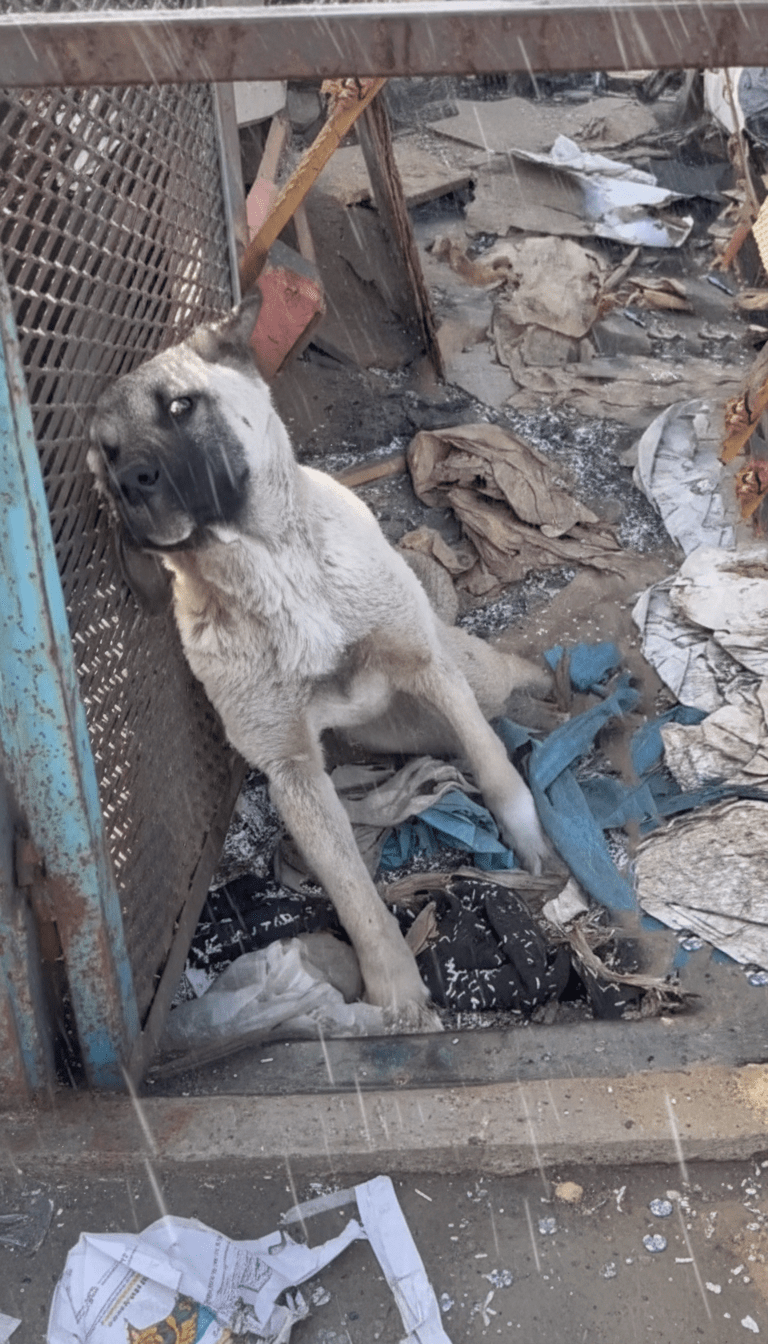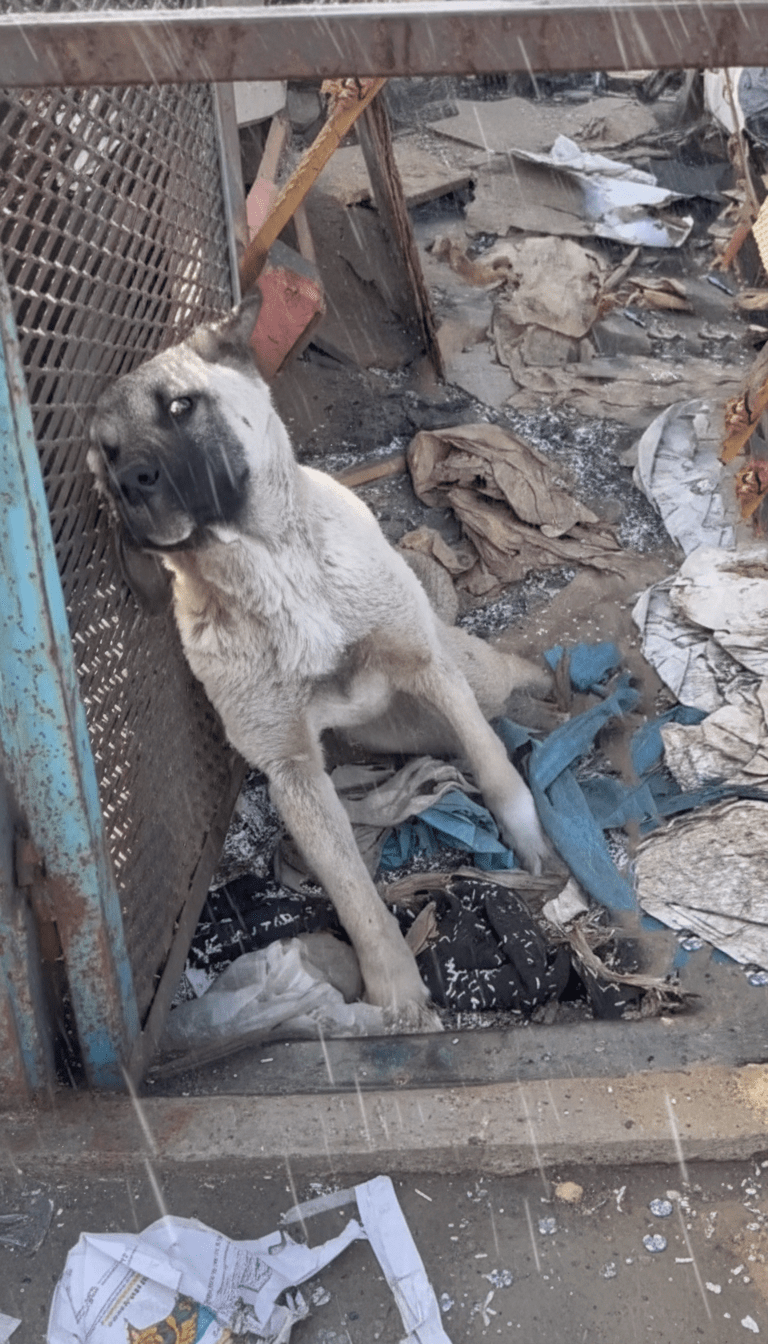In the rain-soaked wreckage of an abandoned construction yard on the dusty outskirts of Gaziantep, Turkey, a gaunt, mud-caked shepherd mix later named Sunko pressed his trembling body against a rusted iron gate, his dark eyes fixed on the blurred figures of rescuers who had almost missed him entirely. It was late October 2023, and the city still reeled from the February earthquakes that had flattened entire neighborhoods, leaving thousands of stray animals to fend for themselves amid twisted rebar and shattered concrete. Sunko’s hind legs jutted at grotesque angles—both femurs snapped clean through—yet he dragged himself forward inch by agonizing inch, driven by a spark of life that veterinarians would later describe as nothing short of miraculous. His ribs protruded like the ribs of a forgotten shipwreck; open sores wept beneath matted fur; and toxicology reports would confirm rat poison coursing through his bloodstream at levels that should have killed a dog twice his size. The chicken bones scattered around his makeshift den told the final piece of the puzzle: he had raided a neighbor’s coop in sheer desperation, only to be caught, beaten, and deliberately crippled as punishment. What unfolded over the next six months would captivate animal lovers from Istanbul to Los Angeles, spark international fundraising campaigns, and force Turkish authorities to confront a hidden epidemic of cruelty toward working dogs in the earthquake zone.

The discovery itself was pure serendipity. A volunteer team from the Istanbul-based Hayat Arkadaşları Derneği (Life Companions Association) had been combing the industrial district for surviving cats when 28-year-old civil engineer-turned-rescuer Deniz Kaya noticed a faint whimper beneath the rhythmic drumming of rain on corrugated metal. “I thought it was the wind at first,” Kaya recalled in an exclusive interview with Global Animal Rescue Chronicle. “Then I saw the paw—thin, filthy, pushing through a gap no wider than my fist.” Peering through the downpour, she spotted Sunko wedged between a collapsed cement mixer and a pile of waterlogged cardboard. His front legs were splayed in exhaustion, but his head remained defiantly upright, tongue lolling in a silent plea. The team’s veterinarian, Dr. Elif Özdemir, knelt in the mud and immediately recognized the signs of deliberate trauma. “The fractures were old—maybe ten days—already starting to knit in misalignment,” she explained. “Whoever did this wanted him to suffer slowly.”
Transporting Sunko proved harrowing. With no functioning animal ambulance available in the quake-damaged region, the volunteers fashioned a stretcher from plywood and duct tape, sliding him onto it while he whimpered but never snapped. En route to a makeshift clinic in a converted school gymnasium, Özdemir administered painkillers and fluids through a vein in his emaciated foreleg. Blood tests revealed not only rat poison—likely bromadiolone, a common anticoagulant—but also severe anemia and a raging infection from untreated wounds. “His clotting factors were almost nonexistent,” Özdemir said. “One wrong move and he would have bled out internally.” Against protocol, she authorized an emergency vitamin K1 injection and plasma transfusion donated by a local blood bank originally intended for human patients—a decision that would later draw both praise and bureaucratic scrutiny.
Word of the “broken-leg dog” spread like wildfire on Turkish social media. Within 48 hours, the hashtag #SunkoYaşasın (“Let Sunko Live”) trended nationwide, amassing 2.3 million posts. A viral video filmed by Kaya—showing Sunko lifting his head to lick her hand despite his agony—racked up 15 million views on TikTok and prompted an unexpected donation from a Saudi prince who wired €25,000 with a single-line message: “No creature deserves this.” Yet the road to recovery was anything but smooth. Surgeons at Ankara University’s Veterinary Faculty faced a dilemma: the misaligned fractures required complete re-breaking and titanium plating, a procedure costing upwards of $8,000 and carrying a high risk of fatal hemorrhage given Sunko’s poisoned state. In a stroke of ingenuity, third-year resident Dr. Mert Çelik proposed a hybrid approach: custom 3D-printed external fixators modeled on human Ilizarov frames, combined with hyperbaric oxygen therapy borrowed from a nearby human burn unit. The fixators—lightweight carbon-fiber rings connected by adjustable rods—allowed gradual realignment without reopening the wounds, while twice-daily oxygen sessions accelerated tissue healing.
As Sunko’s body began to mend, his spirit revealed layers no one anticipated. Rehabilitation therapist Aylin Boz, assigned to his case, noticed that he refused to eat unless someone sat beside him. “It wasn’t just fear,” she observed. “He was testing us—waiting to see if we would leave.” Boz introduced a retired therapy golden retriever named Pamuk as a companion, and the transformation was astonishing. Within a week, Sunko was nudging Pamuk’s food bowl, then attempting to stand on wobbling legs to follow her across the room. Security cameras captured a pivotal moment at 3:17 a.m. on November 12: Sunko, alone in the kennel, rose unassisted for the first time, took three shaky steps, and collapsed—only to repeat the effort until dawn. The clip, shared by the clinic, prompted an outpouring of overnight donations totaling $42,000 from as far afield as Brazil and Japan.

International attention peaked in December when BBC World aired a 12-minute segment titled “The Dog Who Refused to Die.” Viewers learned that Sunko’s breed—likely a Kangal-Anatolian shepherd cross—had been prized for centuries by Turkish nomads for guarding flocks against wolves, yet many were abandoned after the earthquakes displaced their human families. The segment included drone footage of similar construction-yard prisons across southeastern Turkey, exposing a network of informal “punishment pens” where owners dumped dogs caught stealing livestock. Animal-welfare NGO HAYTAP seized the moment, lobbying the Turkish Parliament for stricter penalties under Article 151 of the Penal Code. By January 2024, amendments were passed mandating microchipping of all working dogs and jail terms of up to three years for deliberate maiming.
Sunko’s physical recovery culminated on February 6, 2024—exactly one year after the first quake. In a ceremony attended by 200 supporters and livestreamed to 1.2 million viewers, he walked unaided across a red carpet laid inside the gymnasium, his once-bony frame now carrying 28 kilograms of muscle. But the surprises kept coming. Genetic testing requested by a curious donor revealed trace wolf DNA—less than 2%, yet enough to explain his extraordinary resilience and the unusual silver mask across his muzzle. Breed experts from the University of California, Davis, flew in to study him, publishing a paper in Canine Genetics and Epidemiology suggesting that low-level wolf introgression might enhance clotting efficiency under stress, a trait that could explain why Sunko survived the poison when others perished.
Adoption offers flooded in from Germany, Canada, and the United States, but Sunko’s final chapter unfolded closer to home. Deniz Kaya, the engineer who first found him, had quietly applied to foster him during rehabilitation. When the clinic announced he was ready for a forever home, Kaya’s application rose to the top—not because of celebrity, but because Sunko refused to enter any vehicle unless she was present. On March 21, 2024, he boarded a specially modified van for the 12-hour journey to Kaya’s small farm in İzmir, where he now patrols olive groves alongside Pamuk and a rescued goat named Zeytin. Satellite imagery shared by Kaya shows Sunko’s nightly route: a perfect 400-meter circle around the farmhouse, as if still guarding the flock he never had.
The Sunko Fund, established with leftover donations, has since financed mobile clinics serving 14 earthquake-affected provinces, spaying/neutering over 6,000 animals and distributing 12 tons of veterinary-grade food. In Gaziantep, the very yard where Sunko was found has been converted into a memorial park featuring a life-size bronze statue of him mid-stride, legs strong, eyes forward. Engraved beneath are the words he never spoke but somehow conveyed: “Love is stronger than poison.”
Veterinarians still marvel at the numbers. Survival odds for anticoagulant rodenticide poisoning exceed 90% with prompt treatment—but Sunko received none for at least a week. Compound that with bilateral femoral fractures, starvation, and sepsis, and statisticians at Cornell University’s College of Veterinary Medicine calculate his chances at less than 0.3%. “He’s a living rebuttal to probability,” Dr. Özdemir says, stroking the silver mask that now gleams under the Turkish sun. “Every time I see him run, I remember that medicine can only open the door. The will to walk through it? That was all Sunko.”
From the rubble of Gaziantep to the olive-scented hills of İzmir, one dog’s refusal to surrender has rewritten rescue protocols, tightened laws, and reminded a grieving nation that even in the darkest ruins, hope can drag itself forward on broken legs—and emerge whole.






